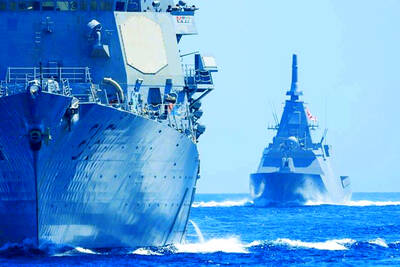The global economic crisis, added to missteps by the administration of former president George W. Bush, widened the space between the US and Asia in a process that could have far reaching implications economically and politically, Simon Tay argues in a timely new book.
While the re-emergence of China as a regional power, and the attendant US malaise, figure prominently in Asia Alone, the seeds of the growing divide between Washington and Asia, Tay tells us, were actually sown during the Asian Financial Crisis of 1997-1998. What Tay refers to as the “Asian surrender” is epitomized by then-IMF president Michel Camdessus “standing imperiously, arms folded,” while Indonesian president Suharto signed harsh IMF prescriptions to save his country’s economy. At the APEC summit in Kuala Lumpur the following year, then-vice president Al Gore “surprised” his audience during a dinner for business leaders by calling for greater democracy in Asia rather than delivering the expected pro-business slogans.
What Camdessus and Gore managed to accomplish, the author claims, is to alienate a community of nations that was slowly beginning to come together, an insult that in the following decade would be exacerbated by Bush’s “arrogance” and poor showing on human rights and US exceptionalism during the financial crisis, where it avoided the very prescriptions imposed by the Washington-based IMF in 1997-1998.
As regional organizations like APEC and ASEAN came into being, a sense that Asia, with the Chinese powerhouse at its center, could act more independently — or beyond that, isolate itself from the rest of the world, in a feat of self-sufficiency — has slowly emerged. Spurred by nationalism (mostly in China), this development was compounded by the global economic crisis, which gave rise to finger pointing, with the US more often than not at the receiving end.
Tay warns us that if that trend were to continue, the US could find itself excluded from a region that is increasingly seen as both the global engine for growth and a source of conflict. Such an outcome, he argues, is undesirable, as the US remains the greatest guarantor of the stability and security that contributed to Asia’s rise in the first place. Furthermore, as ASEAN has yet to prove its mettle as an effective guarantor in terms of conflict resolution and a forum for problem solving, and with a power imbalance within the region probably unseen elsewhere, no single country, let alone multilateral body, has the capacity to fill the vacuum that would be created by a US retreat. Given lingering historical tensions, such as those between Japan and China, or India and China, the region would face great uncertainty, if not instability, if the pacifying effect of US engagement were suddenly to disappear. As such, replacing one hegemon with another — in other words, substituting the US for China — is not an option for the foreseeable future.
This does not mean, however, that the key to success in Asia lies in a return to the past. In fact, Tay states, the global financial downturn, which led to a relative decline in power for the US vis-a-vis Asia, has permanently altered the global architecture, and there is no going back to the status quo ante. The principal implication of this transformation is that the US will have to adopt a more multilateral approach to Asia, one in which it learns how to cooperate rather than dictate — a role that could take Washington years to become accustomed to, though Tay already gives the Obama administration good marks in that regard.
Rather than step back and lick its wounds, the US must be willing to engage Asia at many levels and depart from the narrowly focused relationship that characterized the Bush era, where Washington’s Asia policy was almost exclusively centered on the “war on terrorism.” Only a self-confident US, one that is strong on the home front and that has regained faith in its economic power, will be able to accomplish this task, Tay argues. A better understanding of Asian customs, mores, culture and history among Americans will also be necessary to allow policymakers to sell such a policy of engagement to the public, which otherwise could adopt a xenophobic — or rather sino-phobic — view that could affect the political leaders who are voted into office.
Similarly, fears of China’s rise will only be assuaged if Beijing restrains nationalistic fervor among its people and engages the US in a constructive manner on such issues as global warming, nuclear non-proliferation, regional security and economic stability. There is no question that a “go-it-alone” attitude on China’s part, along with regional economies that could choose to bandwagon on Beijing’s rise and gang up against the US, would be detrimental to addressing many of the region’s problems, old and emerging. On economics alone, China stands to lose tremendously if its policies feed into US fears and result in protectionist policies in Washington. Despite its strong economic showing, the fact remains that China will for many years continue to be an export-driven economy whose domestic consumption is insufficient to spur economic growth.
In sum, the prescriptions outlined in the book apply as much to the US as they do to China, and Singapore-based Tay is well positioned to make them.
The picture that emerges from Asia Alone is one where despite its unprecedented gravitas, Asia remains a loosely knit collection of disparate states whose future direction will likely be contingent on how the US and the major regional players, namely China, Japan and India, address the challenge of a reordered context in the wake of the global financial crisis. Greater intra-regional cooperation, where all the players are treated as equals rather than being lorded over by a regional hegemon, and continued, albeit more restrained, engagement by the US, could be what’s required to secure the future of a region that remains rife with deep historical scars, tremendous developmental inequality, and uncertainty.
Tay’s book says little about the Taiwan question — a blind spot, given the central role the country plays in Sino-US relations — and was written before the Economic Cooperation Framework Agreement (ECFA) between Taiwan and China was signed. That said, it provides a useful overview of the complexities arising from Asia’s emergence and manages to do so in a format that, despite its focus on economics, is both engaging and informative.
One glaring historical mistake is a reference to al-Qaeda leader Osama bin Laden living and studying in the US “for many years” before the Sept. 11, 2001, terrorist attacks. Despite Tay’s claim, bin Laden is only known to have visited the US for two weeks in 1979, with his wife, while seeking medical treatment for one of their sons.

The Nuremberg trials have inspired filmmakers before, from Stanley Kramer’s 1961 drama to the 2000 television miniseries with Alec Baldwin and Brian Cox. But for the latest take, Nuremberg, writer-director James Vanderbilt focuses on a lesser-known figure: The US Army psychiatrist Douglas Kelley, who after the war was assigned to supervise and evaluate captured Nazi leaders to ensure they were fit for trial (and also keep them alive). But his is a name that had been largely forgotten: He wasn’t even a character in the miniseries. Kelley, portrayed in the film by Rami Malek, was an ambitious sort who saw in

It’s always a pleasure to see something one has long advocated slowly become reality. The late August visit of a delegation to the Philippines led by Deputy Minister of Agriculture Huang Chao-ching (黃昭欽), Chair of Chinese International Economic Cooperation Association Joseph Lyu (呂桔誠) and US-Taiwan Business Council vice president, Lotta Danielsson, was yet another example of how the two nations are drawing closer together. The security threat from the People’s Republic of China (PRC), along with their complementary economies, is finally fostering growth in ties. Interestingly, officials from both sides often refer to a shared Austronesian heritage when arguing for

Among the Nazis who were prosecuted during the Nuremberg trials in 1945 and 1946 was Hitler’s second-in-command, Hermann Goring. Less widely known, though, is the involvement of the US psychiatrist Douglas Kelley, who spent more than 80 hours interviewing and assessing Goring and 21 other Nazi officials prior to the trials. As described in Jack El-Hai’s 2013 book The Nazi and the Psychiatrist, Kelley was charmed by Goring but also haunted by his own conclusion that the Nazis’ atrocities were not specific to that time and place or to those people: they could in fact happen anywhere. He was ultimately

Last week gave us the droll little comedy of People’s Republic of China’s (PRC) consul general in Osaka posting a threat on X in response to Japanese Prime Minister Sanae Takaichi saying to the Diet that a Chinese attack on Taiwan may be an “existential threat” to Japan. That would allow Japanese Self Defence Forces to respond militarily. The PRC representative then said that if a “filthy neck sticks itself in uninvited, we will cut it off without a moment’s hesitation. Are you prepared for that?” This was widely, and probably deliberately, construed as a threat to behead Takaichi, though it